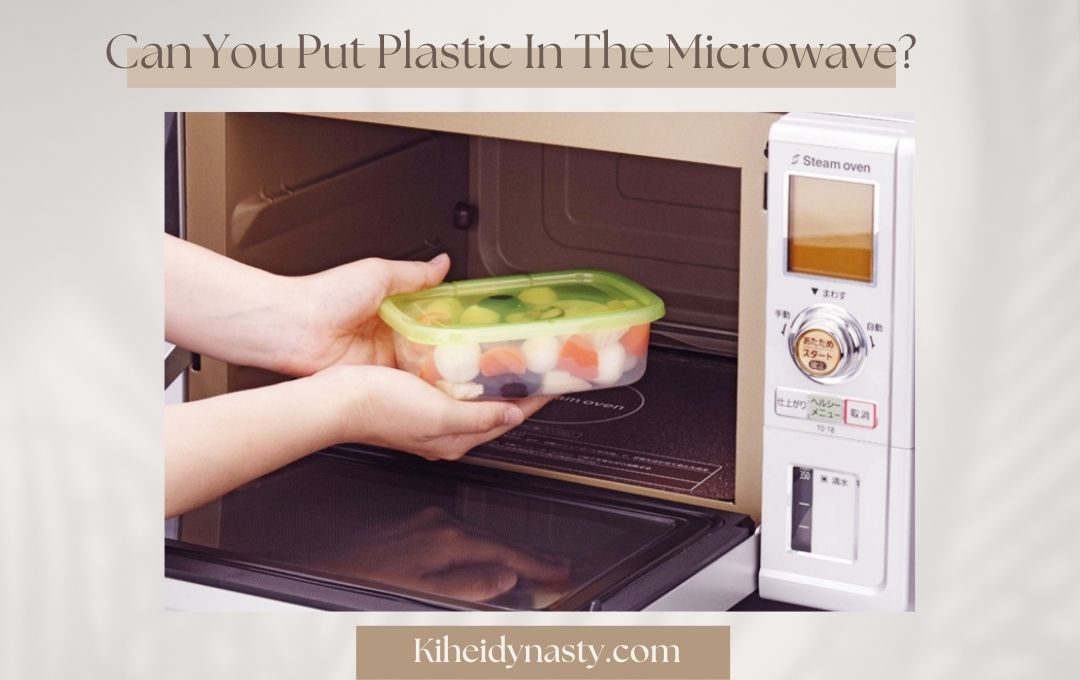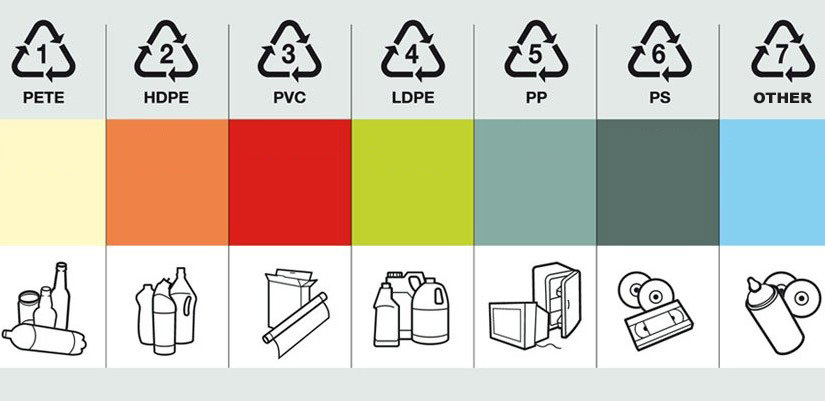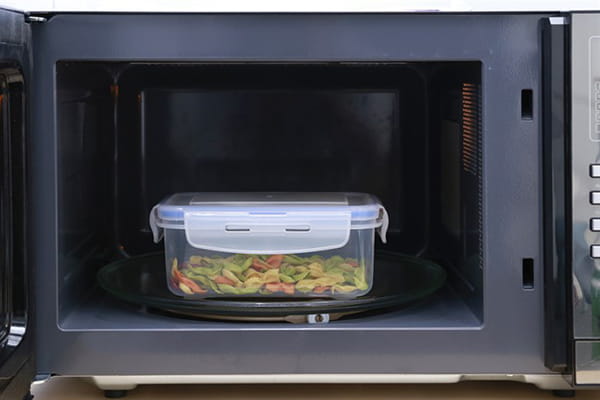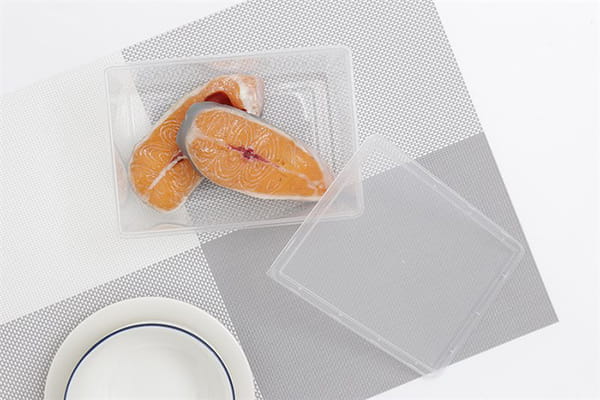It’s the age-old question: Can You Microwave Plastic? The answer is a little more complicated than you might think. While certain types of plastic are microwave-safe, others can release harmful toxins when heated. So, before you heat your next container of leftovers, check its label to ensure it’s safe for the microwave.

What is Plastic?
Plastic is a material made from various synthetic or semi-synthetic organic compounds. It’s used in everything from packaging to toys to building materials. Plastic is durable, lightweight, and easy to mold into different shapes, which is why it’s widely used.
However, not all plastic is created equal. Some types are safer than others when using them in the microwave.
Types of Plastic
There are seven main types of plastic:
- Polyethylene terephthalate (PET or PETE)
- High-density polyethylene (HDPE)
- Polyvinyl chloride (PVC)
- Low-density polyethylene (LDPE)
- Polypropylene (PP)
- Polystyrene or Styrofoam (PS)
- Other: includes polycarbonate, polylactide, acrylic, acrylonitrile butadiene, styrene, fiberglass, and nylon
PET and HDPE are the safest for use in the microwave. PET is the type of plastic used to make water and soda bottles. HDPE is found in milk jugs, detergent bottles, and some reusable water bottles. These two types of plastic are heat-resistant and won’t release harmful chemicals when heated.
PVC and LDPE are not recommended for use in the microwave. PVC contains harmful chemicals like dioxins and vinyl chloride, which can be released when heated. LDPE may also contain harmful chemicals like phthalates, which can leak when heated.
So, if you’re heating food in a plastic container, check the label to make sure it’s made from PET or HDPE. And if you’re not sure, it’s better to play it safe and use a different type of container.
What does the Symbol on My Plastic Cup Mean?

- If you see 1 at the center of the triangle, it marks a polyethylene terephthalate or PETE-grade plastic. This sort of plastic is only appropriate for one-time usage. Generally, it is not advisable to use m microwave with this type of material.
- If you’re number two, you should know that it’s from the high-density polyethylene (HDPE) family. There is debate as to whether or not it should be used. Because there are no real studies on its safety, this type is always avoided.
- The number three is associated with polyvinyl chloride (PVC) and has particular resonance in the plastics industry. Food containers made of this material will no longer be available. It contains a harmful chemical called Bisphenol A (BPA).
- The number 4 refers to low-density polyethylene (LDPE). Nobody suggests this one while microwaving plastic. There is, however, no conclusive research on its safety.
- If you spot number 5 in the triangle, it’s a polypropylene or PP grade plastic. This is the best microwave-safe plastic available. Because it has an excellent heat resistance and does not distort or melt readily, type 5 plastic is microwavable.
- 6 is the number for polystyrene or PS, which should not be used in a microwave. Furthermore, it is non-recyclable and causes environmental pollution.
- If you find the number 7 embossed on a plastic container at the triangle’s center, you can assume it’s acrylic, polycarbonate, nylon, polylactic fibers, or fiberglass. These materials are not considered microwave safe.
Microwave-Safe Plastic

Containers labeled “microwave-safe” can be heated without fear of leaching toxins into your food. These containers are usually polypropylene, polyethylene terephthalate (PET), or high-density polyethylene (HDPE).
You can tell if a container is microwave-safe by looking for a symbol on the bottom or back. The symbol looks like a set of wavy lines and indicates that the material can withstand high temperatures without damage.
Not Microwave-Safe Plastic
The harmful effects of plastic food containers are becoming more apparent. The two primary offenders are artificial chemicals known as phthalates and Bisphenol A (BPA), commonly used in plastics to help them maintain their form and flexibility.
These compounds, known as “endocrine disrupters,” have been discovered to impact hormones like estrogen and testosterone, which can contribute to reproductive and other medical issues. They may be particularly dangerous for children, stopping proper growth and development.
Heat might cause BPA and Phthalates to leach into your meals. That means, yes, sorry – you should avoid heating food and beverages in plastic containers. Instead, use microwave-safe glass or ceramic dishes instead of plastic ones to cook your food.
On the other hand, plastic containers that are not labeled “microwave safe” should not be heated in the microwave. These plastics may release harmful chemicals into your food when they’re heated.
Some examples of non-microwave-safe plastics include polystyrene (Styrofoam), acrylonitrile butadiene styrene (ABS), and plastic with recycling codes 1, 3 (phthalates), 6 (styrene), and 7 (bisphenols), and polyvinyl chloride (PVC). If you see these plastics listed on the label, it’s best to heat your food in a different container.
So, Can You Put Plastic In the Microwave?
The answer is yes and no. Some types of plastic are safe to use in the microwave, while others should be avoided. Be sure to check the label before heating up your food to play it safe. Safer options will be labeled 2, 4, and 5.
The federal government’s Food and Drug Administration (FDA) has approved using a specific microwave-safe plastic symbol to determine if a particular container is safe for use in the oven. The image of a microwave and three to five wavy lines inside it, signifying microwave energy, are included on this indicator.
Why does Plastic Melt in the Microwave?
When microwaving, the waves cause water molecules in the food to vibrate. This generates heat and causes the food to cook. The same thing happens to plastic, but it doesn’t have the same properties as food.
Instead of generating heat, the microwaves cause the plastic molecules to vibrate. This friction creates heat, which can cause the plastic to melt.
How to Use Plastic Safely in the Microwave?

If you do choose to microwave food in plastic containers, there are a few safety tips to keep in mind:
- Never put plastic wrap in the microwave. It can melt and stick to your food or cause sparks.
- Don’t let plastic wrap touch the food during cooking. The heat can cause chemicals to leach into the food.
- Avoid microwaving plastic containers with darkening or warping. These signs indicate that the container has been damaged and might not be safe.
- Replace old or worn plastic containers. They may be more likely to leak chemicals into your food.
- Only use plastic containers that are specifically labeled “microwave safe.”
- Choose phthalate-free and BPA-free products.
- Use paper towels, not plastic, to cover food. If you use plastic lids, remember that they could contain phthalates.
- Avoid storing food in disposable plastics.
- Never put frozen plastic containers in the microwave to thaw.
- When cooking for a group, it’s usually best to prepare everything simultaneously.
How to Avoid Plastic Containers
If you’re looking to avoid plastic altogether, your best bet is to invest in some glass or ceramic containers. These materials are not only safe for the microwave, but they’re also free of harmful chemicals.
Another option is to use silicone storage bags, which are made of safe, food-grade material and can be reused multiple times. You can also find reusable beeswax wraps, a sustainable alternative to plastic wrap.
When microwaving your food, it’s always better to err on the side of caution. If you’re unsure whether a certain type of plastic is safe, it’s best to avoid using it altogether. Plenty of other options available will do the job just as well – without the risk.
You may like:
FAQs
Q. Can I Put a Plastic Bag in the Microwave?
A. No. Plastic bags do not microwave safe and can melt, causing sparks and potentially starting a fire.
Q. How do I Know If Plastic is Microwave Safe?
A. You can usually tell if plastic is microwave safe by looking for a microwave-safe symbol on the label. This symbol is usually accompanied by the image of a wavy line, signifying microwaves.
Q. Is It Safe To Reheat Food In Plastic Containers?
A. It’s generally safe to reheat food in plastic containers, as long as they’re labeled “microwave safe.” However, it’s always best to err on the side of caution and avoid using any damaged or worn plastic.
Q. How Long Can Plastic Be Microwaved?
A. Plastic can usually be microwaved for up to 2 minutes without any problems. However, it’s always best to check the label of your particular container to be sure.
Q. Can I Put Plastic Wrap in the Microwave?
A. No. Plastic wrap is not microwaved safe and can melt, causing sparks and potentially starting a fire.
Q. What if Plastic Melts in Microwave?
A. Plastic melts in the microwave can release harmful chemicals into your food. It’s best to avoid using any plastic that is damaged or worn.
Q. Is It Ok to Eat Melted Plastic?
A. No. Eating melted plastic can be harmful to your health. Plastic melts in the microwave can release harmful chemicals into your food. It’s best to avoid using any plastic that is damaged or worn.
Q. How do I Clean a Melted Plastic Mess in the Microwave?
A. First, unplug the microwave and allow it to cool. Once it’s cooled, remove any pieces of melted plastic from the interior and dispose of them properly. Next, clean the inside of the microwave with soapy water and a sponge. Finally, wipe down the exterior of the microwave with a damp cloth.
Q. Can You Microwave Ziploc Bags?
A. Yes, they can. Ziploc bags may be microwaved and designed to be used in this manner.
Q. Is It Safe To Microwave Vegetables In A Plastic Bag?
A. Steam-bag veggies are non-toxic and safe to use in the microwave. They do not contain BPA or phthalates.
Microwaving Plastic – Final Thoughts
Can You Put Plastic In The Microwave? Yes, but some types of plastic are safer than others.
The best way to avoid using plastic is to invest in some glass or ceramic containers. These materials are not only safe for the microwave, but they’re also free of harmful chemicals.
Another option is to use silicone storage bags, which are made of safe, food-grade material and can be reused multiple times. You can also find reusable beeswax wraps, a sustainable alternative to plastic wrap.
When microwaving your food, it’s always better to err on the side of caution. If you’re unsure whether a certain type of plastic is safe, it’s best to avoid using it altogether. Plenty of other options available will do the job just as well – without the risk.
Read more Articles here.
- How Long To Bake Salmon At 425 in Foil? - December 11, 2022
- How Long To Cook Chuck Roast In Oven At 350? - December 11, 2022
- How Many Chicken Wings Are In A Pound? - November 26, 2022
